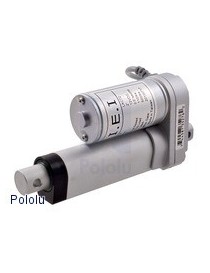

No products in the cart.


Concentric LACT2-12V-20 Linear Actuator: 2" Stroke, 12V, 0.5"/s
The LD Series of linear actuators by Concentric International (formerly Iowa Export-Import) are 12V DC gearmotors that use a worm drive to move a shaft back and forth along its length. The worm drive ensures that the shaft will hold its position even when unpowered. Two limits switches safely stop the motor at either end of its range, while integrated diodes allow it to reverse direction after reaching a limit point if the supplied voltage is reversed. The actuators are mostly metal, and the entire case is sealed to protect against dust and water (rated IP63).
| Connecting the bracket to one end of a Concentric LD linear actuator. |
|---|
The Concentric LD series linear actuators are available in a variety of lengths and with optional potentiometers that are linked to the shaft position, for use in feedback systems. Several lengths are also available in two gear ratios: 5:1 and 20:1. The 5:1 versions have lower load ratings—34 lbs dynamic, 450 lbs static—but allow for higher speeds, up to 1.7 in/s. The 20:1 versions are slower—up to 0.5 in/s—but are rated for dynamic loads up to 110 lbs and static loads up to 500 lbs.
| Stroke length | 20:1 | 20:1 w/feedback | 5:1 | 5:1 w/feedback |
|---|---|---|---|---|
| 2? | LACT2-12V-20 | LACT2P-12V-20 | ||
| 4? | LACT4-12V-20 | LACT4P-12V-20 | LACT4-12V-5 | LACT4P-12V-5 |
| 6? | LACT6-12V-20 | LACT6P-12V-20 | ||
| 8? | LACT8-12V-20 | LACT8P-12V-20 | ||
| 10? | LACT10-12V-20 | LACT10P-12V-20 | ||
| 12? | LACT12-12V-20 | LACT12P-12V-20 | LACT12-12V-5 | LACT12P-12V-5 |
We also have generic linear actuators that can generally be used as less expensive alternatives to the ones from Concentric; the table on our linear actuator category page can help you find the actuator with the combination of speed and force that best meets your project’s requirements.
Mounting brackets are available for attaching the actuators to a structure; two are required for each actuator. Our bracket for generic linear actuators also work with the LD actuators, although they are a little loose.
| Concentric linear actuator with feedback, 4"" Stroke (LACT4P), shaft fully extended. |
|---|
To test-drive the actuator, simply connect a power source of up to 12 V to the motor leads. Reversing the applied voltage will reverse the direction of motion. A motor controller or motor driver is required for electronic speed and direction control. We recommend our Jrk Motor Controllers for use with the feedback actuators and the Pololu Simple Motor Controller 18v7 for controlling the actuators without feedback, though many of our other motor controllers and motor drivers are capable of powering this actuator.
These actuators have a stall current of 10 A at 12 V, but they will, on average, draw far less than this when used within their load ratings. They draw around 500 mA with no load and can exceed 3 A at their maximum rated dynamic load, so we have found they generally work well with our lower-power jrk 21v3 motor controller with feedback (see the bottom of this page for more information using this controller for closed-loop linear actuator position control). Note, however, that the actuators can briefly draw close to their full stall current when abruptly started or on a sudden change of direction. Such current spikes can be dampened if you take steps to limit the acceleration of the actuator (many of our motor controllers offer optional acceleration limiting).
The feedback feature included with our jrk motor controllers make them a great solution for precisely controlling our linear actuators with feedback. Our settings file for the jrk configuration utility makes setup easy, eliminating the need to calibrate the feedback and tune the PID constants. To get started, follow the steps below:
| Connecting a linear actuator with feedback to a jrk 21v3 motor controller. |
|---|
While this setting file gives precise control over most of an actuator’s range, you might find decreased performance very near the extremes due to the limit switches. If your project requires better control near the actuator’s limits, you might need to recalibrate the feedback settings for your particular actuator.
"